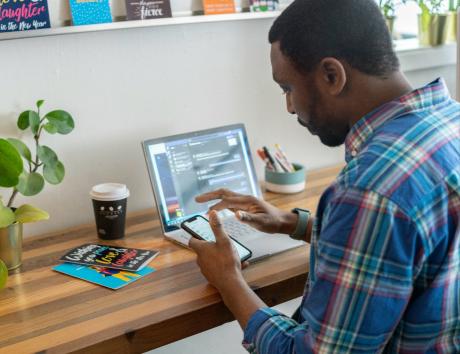Writing a LinkedIn cover letter
LinkedIn is a popular professional social network that allows employers to post open positions and receive applications. In some cases, these applications require a cover letter submitted directly through the platform. While a LinkedIn cover letter is similar to a standard one, being on the platform allows you to leverage certain personalization features to impress recruiters and give you the best chance of landing the job you want.

How to make a cover letter on LinkedIn
When it comes to cover letter examples, LinkedIn doesn’t supply any. The platform has its own set of rules and expectations, and it's important that you follow them. Here are a few things you need to know about navigating the process and making sure your professionalism shines through.
Search for a job post
LinkedIn makes it easy for job hunters to search for roles they’d like to apply for. From your profile page, simply click on the “Jobs” icon at the top of the page. On the “Jobs” page, you’ll be able to see the top opportunities LinkedIn recommends based on the qualifications listed in your profile.
The site will also provide a plethora of other suggestions, including keywords to search, companies hiring for your skills, and jobs where you’re likely to be a top applicant.
Apply through the “Apply” or “Easy Apply” functions
When you choose a particular role, LinkedIn will show you a detailed job description, as well as the posting date, number of applicants, and current employees you may know. There will also be an option to either apply for the position or save the posting to come back to it later.
To apply for the position, click the “Apply” button. In some cases, this button will take you to the employer’s website to submit an application through their online system. If there’s an “Easy Apply” button, clicking it will usually take you to an on-platform application.
There, you’ll be asked to upload your resume as a file attachment, fill in your personal details, and possibly answer a few questions. There may also be a message box where you can type your cover letter.
Personalize your cover letter
Applying on LinkedIn provides added benefits for applicants. In many cases, you’ll have the unique ability to see who posted the job and what their role is. There’s often a button next to this feature that allows you to message that person to ask questions about the posting.
The bottom of the job description also usually includes a link to the company page. From there, you can sometimes see the profiles of employees in key roles.
You can also click the “People” tab on an employer’s LinkedIn page to search for the name of a hiring manager. This will help you personalize the cover letter templates you use so you can address them to the right person instead of simply including a generic greeting.
Highlight relevant skills and experience
Another benefit of using LinkedIn to apply is that employers can see the relevant skills and experience listed in your profile. Consequently, they’ll be able to cross-reference the skills you include in your cover letter and resume.
Though many resume articles may tell you that this information is sufficient for your letter, keep in mind that LinkedIn doesn’t always provide adequate space to discuss your skills in context. Your profile won’t be able to align those skills with the employer’s posted job description.
For that reason, it’s important to connect the dots for the employer in your LinkedIn cover letter, explaining how your background, skills, and experience have set you up for success and make you the best candidate for the position.
This tactic is crucial for differentiating yourself from other applicants on LinkedIn and is especially important for roles where the platform indicates that there are already many applicants.
Include a call to action
This is one way writing a LinkedIn cover letter aligns with the conventional wisdom found in many cover letter articles.
Make sure to end your cover letter with a clear prompt for the person reading it to take the next step in the hiring process. Reiterate your enthusiasm and invite them to view any materials or portfolios you’ve included on your profile or application.
Tell the hiring manager you’d love to set up an interview or a time to talk further about how you can help the company reach its goals. Let them know you’re available to chat through LinkedIn and provide another contact method in case they prefer an alternative venue.
Proofread and edit
LinkedIn makes writing a cover letter quite easy. That said, it’s important to remember that while social media platforms can seem casual, that doesn’t mean you should take your cover letter and application any less seriously.
To appear as professional as possible, make it a point to proofread and edit your LinkedIn cover letter and resume to confirm that they’re error-free. If you’ve used a cover letter or resume template, alter parts of it to reflect your unique skills and background.
Send your application
Once everything is complete, submit your job application on LinkedIn by clicking the appropriate button. You also have the option to save your application so you can finish and submit it later.
Remember that employers can’t see your application until it’s submitted. If you forget to take this step, you won’t be in the running for the position you’re interested in.
Expert Tip:
To-do’s after sending your application
You may wonder what happens next once your application package is in the employer’s hands. Unlike the company’s applicant tracking system (ATS), which may or may not give updates about your application, you can track your applications on LinkedIn.
Simply navigate to the “Jobs” tab on your profile, click “My Jobs” on the left-hand side, and choose “Applications” to see the jobs you’ve applied for. You can also adjust your notification settings to receive job application updates via email or the LinkedIn app, including recruiter views or resume downloads.
If you want to continue your job hunt and submit another resume and cover letter, LinkedIn makes it easy. If requested or given room to do so, including a LinkedIn cover letter in each of those applications can go a long way toward helping you stand out amongst a sea of applicants.
Finally, if you haven’t heard back from the company within one to two weeks, consider sending a follow-up message via LinkedIn.
Remind the hiring manager or recruiter of your qualifications, highlight why you’re a great fit for the role, and let them know you’re enthusiastic about the possibility of an interview to discuss how you can be of value to the company.
“While social media platforms can seem casual, that doesn’t mean you should take your cover letter and application any less seriously.”
Use LinkedIn to your advantage in your search for the perfect role
As easy as it is to apply for a job on LinkedIn, it’s still important to ensure that your cover letter and application come across as poised and professional.
Before applying, familiarize yourself with the platform functions and use them to research the recruiter or hiring manager’s name. When you write your cover letter, personalize your greeting using that name instead of going with something more generic.
Additionally, give context to the experience and skills you’ve listed and explain why you’re a good fit for the role, using your LinkedIn profile as a resume example of sorts. Include a call to action at the end, and don’t forget to proofread your letter before sending it off.
If you’re coming up blank trying to compose your letter, consider using a LinkedIn cover letter example as your guide.
Reviewing cover letter and resume examples can help you determine the appropriate structure and maintain a professional tone throughout. With the right resources, you can draft a standout cover letter that gets your application moved to the top of the digital stack.
Download a perfectly written cover letter
Write a cover letter step-by-step with our intuitive generator.



